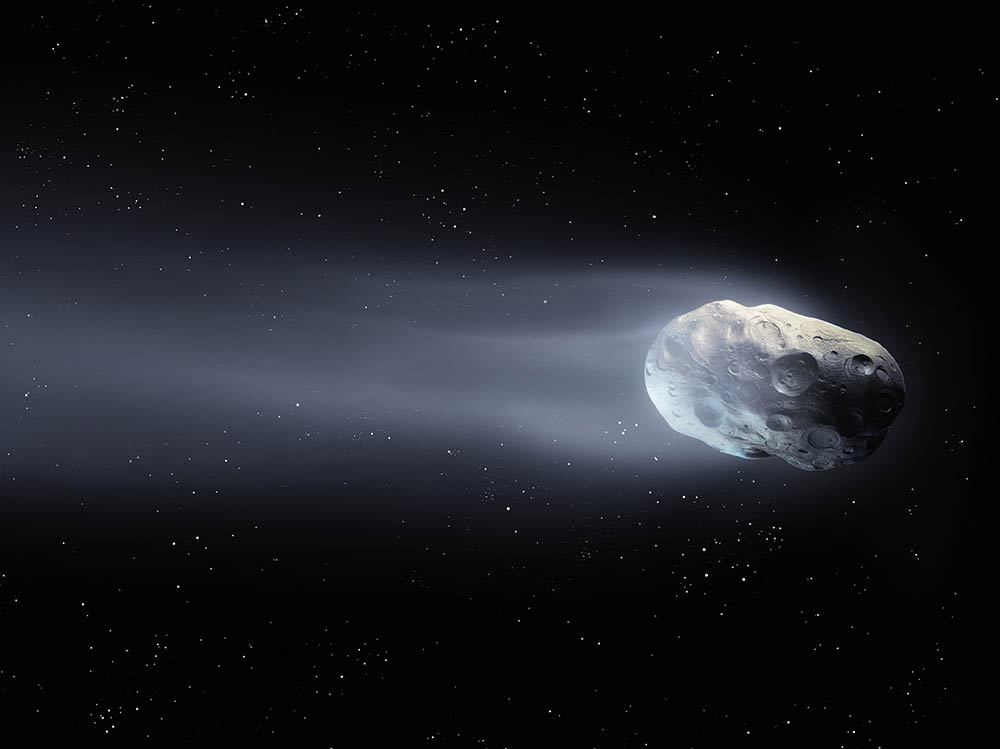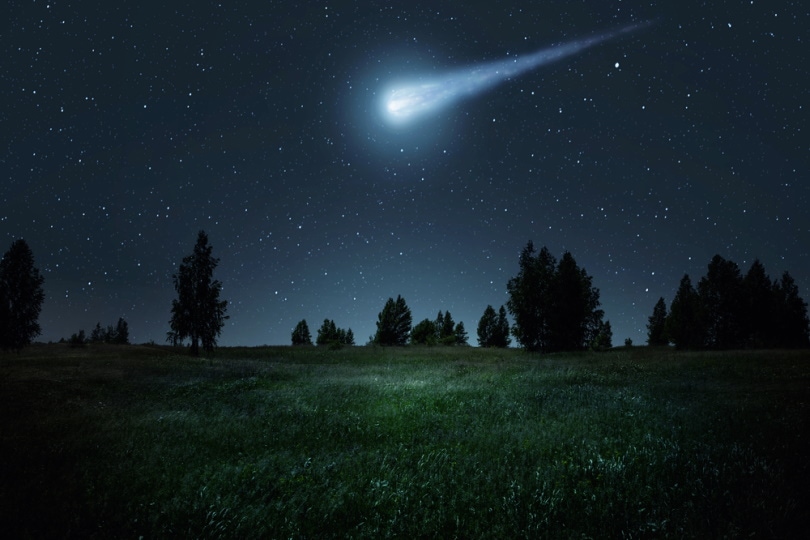Why Do Comets Have Tails? What You Need to Know!
Last Updated on

There’s no doubt that there’s something new to learn about the cosmos every day, leading to more questions about why. For example, you’ve probably wondered once or twice why comets have fiery tails trailing behind them.
Well, the answer is pretty simple. Comets have tails because their speed creates immense heat, evaporating their gases and emitting dust, electrons, and ions. These microparticles form the shape of a tail trailing behind the comet due to the Sun’s radiation pressure.
We may think planets and stars are the most exciting aspects of our universe, but comets are equally fascinating. Keep reading to learn what you need to know about comet tails, why they exist, and how they’re formed.

What Are Comet Tails?
The internet may have told you that comets are rocks, but a better way to describe them would be gigantic, dirty snowballs. These dirty and icy objects are often seen with a fuzzy trail behind them, which is caused mainly due to the Sun’s radiation pressure.
Comet tails are a formation of dust, electrons, and ions that originate from the comet’s gases. These gases evaporate rapidly whenever the comet comes close to the Sun, resulting in the tail forming behind the comet.
We’re available to see these tails glimmering from afar because the sunlight reflects off the microparticles. In addition, the Sun’s radiation pressure affects the flow and direction of the comet’s tail, making it trail behind the comet vigorously as the comet approaches the Sun.

Types of Comet Tails
There are two types of comet tails because a comet interacts with the Sun in two ways. The first tail is formed due to sunlight and comet dust, and you may think that’s all there is to it. The other comet’s tail is influenced by the solar wind.
The solar wind consists of charged particles, such as protons and electrons, escaping the Sun’s surface because of their high velocity. We already know that comets produce ionized gas; when these charged particles interact with the ionized gas, the second tail is formed.
The first is a dust tail with an open end, like a broom’s bristles, due to the comet nucleus’s orbital action and sunlight’s pressure. Meanwhile, the second tail is called a plasma tail and takes the formation of a straight line.
Why Do Comets Have Tails?
In simpler words, comets have tails due to the Sun’s radiation pressure, wind, and light. Let’s elaborate on how some of these factors influence the existence of comet tails and what the interaction can look like.

Sublimation
One of the simplest and main reasons a comet has tails is sublimation. As the dirty and icy object nears the Sun, the comet’s molecules are heated enough to overcome other attractive forces and enter the vapor stage directly.
As mentioned earlier, these vapors attract space dust and form an atmosphere around the tail. Then, the atmosphere forms into a tail due to the force from solar radiation pressure. As a result, sublimation and radiation pressure cause the existence of comet tails and their speed.
Light Pressure
The first important idea is that light is an electromagnetic wave. This means when something in space travels at the speed of light, the electric and magnetic feels move according to Maxwell’s equations.
In space, particular objects experience pressure when they absorb light, called “light pressure.” Meanwhile, “radiation pressure” changes the momentum of an object when a photon reflects off of it.
You may find that confusing because photons are weightless, but they have momentum since they have wave characteristics. Plus, this momentum is stronger than expected. So, you can compare the Sun’s radiation pressure influencing 1 square meter of Earth to a 1-gram object traveling at 7 millimeters per second.
So, you’ll find that space dust particles impact Earth much more than gravity, air friction, and other factors. As a result, the concept of a photon rocket and its speed is thought to be why comets have tails.
Space Dust
As we mentioned, space dust is a significant contributor to comets’ tails. However, the relationship between space dust and light pressure is somewhat strange. Firstly, it’s worth noting that one small particle in Earth’s orbit is nearly one-millionth of a meter in diameter.
The light pressure causes a whirlpool motion, allowing this particle to move towards the Sun, reaching its surface approximately 2,000 years later. The concept of this particle reaching the Sun with the help of light pressure is called the Poynting-Robertson Effect.
It’s easy to think that the sunlight’s pressure would push such a small particle far away from the Sun, but that’s not the case here. Instead, the moving state of the object means it experiences the sunlight’s pressure from a different direction.
As a result, the Sun’s gravity is stronger than the light pressure’s repellency to the particle.
Light Direction
Light direction is the last major factor that influences the existence of comet tails. Undoubtedly, our sense of light direction from Earth is very easily influenced. Due to our planet’s rotation and orbit, the direction of a star’s light can seem different than it is.
This phenomenon is referred to as “phenomenon aberration,” which was discovered after observing changes in stars’ lights’ directions on a seasonal basis. The motion of our planet causes us to think the position of the star has changed, but the light is still impacting the Earth directly.
Another example of this phenomenon is when rain seems to drop in front of us when we’re running, even though it’s only dropping vertically. You can calculate the angles of such aberration. As a result, the phenomenon of aberration confuses the direction of a comet’s tail and the light it emits.

Specifications of a Comet Tail
Have you ever wondered what an average comet and tail look like? Here’s all you need to know about the formation, size, magnetosphere, and loss of an average magnet tail.
Formation
From Earth, comets can be quite hard to detect. However, solar radiation vaporizes the volatile particles within a comet during its approach to the inner Solar System. As a result, these vapors stream out of the nucleus and attract dust on their way out.
These vapors and dust combine to create an atmosphere that we know as a coma. The Sun’s radiation pressure and solar wind force the coma to extend into a tail, pointing away from the Sun.
Each atmosphere component forms its tail: the dust tail and the ion or plasma tail. The dust tail is somewhat curved, called the anti-tail, while the solar wind’s magnetic field influences the ion tail. As a result, it may look like the two tails are pointing away from each other.
Size
The average comet nucleus has a diameter of no more than 10 kilometers, and the ion tails can get as long as 3.8 astronomical units. However, the size of the comet’s atmosphere can be even bigger than the Sun.
Magnetosphere
When astronomers observed anti-tails closely, they were able to discover solar wind. The ion tail is also a product of ultraviolet radiation, separating the electrons from the coma’s microparticles.
These particles ionize and form plasma, inducing a magnetosphere around the comet. The comet works with its magnetic field to prevent outward-flowing solar wind particles from entering its atmosphere.
The comet’s supersonic relation to solar wind causes a bow shock to form above the comet, facing the Sun alongside the solar wind. Cometary ions begin concentrating within this bow shock and loading the solar magnetic field with plasma.
The magnetic field lines wrap around the comet so that the ion tail forms, largely imitating the formation of planetary magnetospheres.

Loss
If the cometary ions load the solar magnetic field with insufficient plasma, the magnetic field lines begin squeezing together. This continues until it results in magnetic reconnection somewhere along the ion tail.
Magnetic reconnection creates highly conducting plasma with rearranged magnetic topology. As a result, a tail disconnection event occurs, previously observed in the comet Encke in 2007. Encke passed through coronal mass ejection, severing the ion tail completely.

Conclusion
Now that you know why comets have tails, you can definitely admit that comets are a lot cooler than they look. Undoubtedly, the science behind the existence of their tails and the influential factors for their formation is interesting enough to pique anyone’s interest.
In simple words, the Sun’s radiation pressure and solar wind cause the comet’s components to sublimate, form an atmosphere, and extend into a tail. The reflection of sunlight makes the comet’s tail visible to us.
Featured Image Credit: Nazarii Neshcherenskyi, Shutterstock
About the Author Jeff Weishaupt
Jeff is a tech professional by day, writer, and amateur photographer by night. He's had the privilege of leading software teams for startups to the Fortune 100 over the past two decades. He currently works in the data privacy space. Jeff's amateur photography interests started in 2008 when he got his first DSLR camera, the Canon Rebel. Since then, he's taken tens of thousands of photos. His favorite handheld camera these days is his Google Pixel 6 XL. He loves taking photos of nature and his kids. In 2016, he bought his first drone, the Mavic Pro. Taking photos from the air is an amazing perspective, and he loves to take his drone while traveling.
Related Articles:
15 Crucial Facts About Ultraviolet Rays & the Sun
What Constellation Is Spica In? The Interesting Answer!
10 Interesting Leo Constellation Facts, Myths, and FAQs
15 Interesting Pegasus Constellation Facts, Myths, and FAQs
6 Interesting Sagittarius Constellation Facts, Myths, and FAQs in 2024!
What Are Constellations? Where Did They Come From?
8 Interesting Libra Constellation Facts, Myths, and FAQs
What Is Infrared Radiation? Science-Based Facts & FAQ
